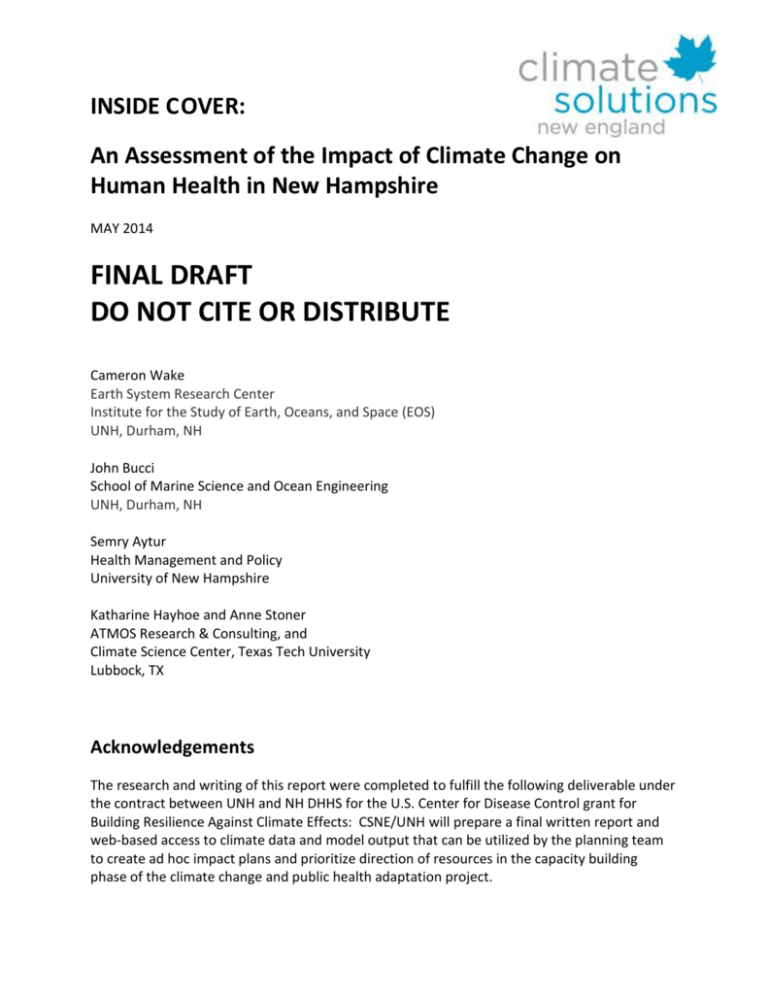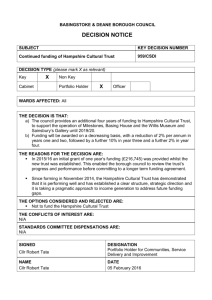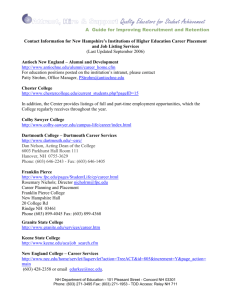
INSIDE C OVER:
An Assessment of the Impact of Climate Change on
Human Health in New Hampshire
MAY 2014
FINAL DRAFT
DO NOT CITE OR DISTRIBUTE
Cameron Wake
Earth System Research Center
Institute for the Study of Earth, Oceans, and Space (EOS)
UNH, Durham, NH
John Bucci
School of Marine Science and Ocean Engineering
UNH, Durham, NH
Semry Aytur
Health Management and Policy
University of New Hampshire
Katharine Hayhoe and Anne Stoner
ATMOS Research & Consulting, and
Climate Science Center, Texas Tech University
Lubbock, TX
Acknowledgements
The research and writing of this report were completed to fulfill the following deliverable under
the contract between UNH and NH DHHS for the U.S. Center for Disease Control grant for
Building Resilience Against Climate Effects: CSNE/UNH will prepare a final written report and
web-based access to climate data and model output that can be utilized by the planning team
to create ad hoc impact plans and prioritize direction of resources in the capacity building
phase of the climate change and public health adaptation project.
Additional support for this report was provided by the National Science Foundation funded
New Hampshire Experimental Program to Stimulate Competitive Research (EPSCoR) project
titled “Interactions among Climate, Land Use, Ecosystem Services and Society.” Visualizations of
the data presented in this report can also be viewed online at the NH EPSCoR Data Discovery
Center (http://ddc.sr.unh.edu). We also thank the several external reviewers who provided
comments and edits that significantly improved the report.
Climate Solutions New England (CSNE)
Core Team
Elisabeth Farrell
Program Manager, Sustainability Institute
University of New Hampshire
Matthew Huber
Professor, Department of Earth Sciences
and
Earth System Research Center
Institute for the Study of Earth, Oceans and Space (EOS)
University of New Hampshire
Tom Kelly
Chief Sustainability Officer
Director, Sustainability Institute
University of New Hampshire
Paul Kirshen
Research Professor, Department of Civil Engineering
and
Earth System Research Center
Institute for the Study of Earth, Oceans and Space (EOS)
University of New Hampshire
Cameron P Wake (CSNE Director)
Research Associate Professor, Earth System Research Center
Institute for the Study of Earth, Oceans and Space (EOS)
and
Josephine A Lamprey Professor in Climate and Sustainability
Sustainability Institute
University of New Hampshire
http://ClimateSolutionsNE.org
ii
Graphic Design:
Brown and Company, Portsmouth, NH
This report can be used under the terms of the Creative Commons AttributionNon Commercial 4.0 International License: https://creativecommons. org/licenses/bync/4.0/legalcode. Cover photos copyrighted by istockphoto.com, all rights reserved.
2014
Climate Solutions New England
Sustainability Institute, University of New Hampshire
107 Nesmith Hall, Durham, NH 03824
iii
Table of Contents
Executive Summary . . . . . . . . . . . . . . . . . . . . . . . . . . . . . . . . . . . . . . .
1
1. Background and Objectives . . . . . . . . . . . . . . . . . . . . . . . . . . . . . . . . . 10
2. Frameworks: Moving from Risk to Resilience . . . . . . . . . . . . . . . . . . . . . . . 13
3. Climate Change: From Global to Local . . . . . . . . . . .
3.1 Background . . . . . . . . . . . . . . . . . . . . .
3.2 Historial Climate Change Across New Hampshire
3.3 Future Climate Change Across New Hampshire .
.
.
.
.
.
.
.
.
.
.
.
.
.
.
.
.
.
.
.
.
.
.
.
.
.
.
.
.
.
.
.
.
.
.
.
.
.
.
.
.
.
.
.
.
.
.
.
.
.
.
.
.
.
.
.
.
. . 16
. . 16
. 17
. 18
4. Climate Impacts on Health . . . . . . . . . . . . . . . . . . . . . . . . . . . . . . . . .
4.1 Heat Stress . . . . . . . . . . . . . . . . . . . . . . . . . . . . . . . . . . . . .
4.2 Extreme Weather . . . . . . . . . . . . . . . . . . . . . . . . . . . . . . . . .
4.3 Respiratory and Cardiovascular Illness (including asthma) . . . . . . . . . . .
4.4 Allergies . . . . . . . . . . . . . . . . . . . . . . . . . . . . . . . . . . . . . . .
4.5 Vector-Borne Diseases . . . . . . . . . . . . . . . . . . . . . . . . . . . . . . .
4.6 Food-Borne Diseases . . . . . . . . . . . . . . . . . . . . . . . . . . . . . . . .
4.7 Water-Borne Diseases . . . . . . . . . . . . . . . . . . . . . . . . . . . . . . .
4.8 Health Behaviors and Chronic Disease . . . . . . . . . . . . . . . . . . . . . .
4.9 Mental Health and Stress-related Disorders Related to Climate Change . . .
21
21
29
34
37
39
46
49
55
57
5. Conclusions and Next Steps . . . . . . . . . . . . . . . . . . . . . . . . . . . . . . . .
62
Tables . . . . . . . . . . . . . . . . . . . . . . . . . . . . . . . . . . . . . . . . . . . . . . 65
Figures . . . . . . . . . . . . . . . . . . . . . . . . . . . . . . . . . . . . . . . . . . . . . . 71
Appendix A: Climate Grids for 38 stations across New Hampshire . . . . . . . . . . . . . 92
Endnotes . . . . . . . . . . . . . . . . . . . . . . . . . . . . . . . . . . . . . . . . . . . .
iv
97
Executive Summary
Background
Climate change threatens human health in many ways. The negative impacts of climate
change on human health are likely to increase in both magnitude and frequency as climate
continues to change in response to ever increasing global emissions of heat trapping gases from
a variety of human activities.1 The Centers for Disease Control and Prevention (CDC) - Building
Resilience Against Climate Effects (BRACE) framework2 provides guidance to states and cities to
develop strategies and programs to confront the health implications of climate change. This
report serves to address Step 1 and Step 2 of the BRACE framework via an assessment of past
and future climate change across New Hampshire combined with an assessment of the impact
of climate change on human health. A key component of the BRACE framework is building
resilience. In public health, resilience is a measure of the ability of a community to utilize
available resources to respond to, withstand, and recover from adverse situations.3 More
generally, people think of resilience as the ability to recover, persist, or thrive amid change. The
New Hampshire Climate and Health Workgroup has tentatively developed the following
definition of resilience: Resilience is the ability and capacity to anticipate, prepare for, respond
to, and recover from significant threats with minimum damage to human health and well-being,
the economy, and the environment.
Past and Future Climate Change in New Hampshire
EARTH’S CLIMATE CHANGES. It always has and always will. However, an extensive and
growing body of scientific evidence indicates that human activities—including the burning of
fossil fuel (coal, oil, and natural gas) for energy, clearing of forested lands for agriculture, and
raising livestock—are now the primary force driving change in the Earth’s climate system. Here
we describe how the climate of New Hampshire has changed over the past century and how
the future climate of the region will be affected by a warmer planet due to human activities.
Overall, New Hampshire has been getting warmer and wetter over the last century, and
the rate of change has increased over the last four decades. Detailed analysis of data collected
at five U.S. Historical Climatology Network meteorological stations (Keene, Durham, and
Hanover, Bethlehem and First Connecticut Lake), show that since 1970:
Average annual maximum temperatures have warmed 0.5 to 2.6oF (depending on the
station) with the greatest warming occurring in fall or winter.
The number of days with minimum temperatures less than 32oF has decreased, and the
coldest winter nights are warming.
The length of the growing season is two to four weeks longer.
Annual precipitation has increased by 7 to 20 percent.
Extreme precipitation events have increased across the region; this increase has been
dramatic at some sites. The impact of this increase in large precipitation events is evident in
the several large floods that have occurred across New Hampshire over the last decade.
1
The number of snow-covered days has decreased across New Hampshire.
In addition, more than a century of observations shows that spring lake ice-out dates
across New Hampshire are occurring one to two weeks earlier today than in the past.
To generate future climate projections for southern New Hampshire, simulated
temperature and precipitation from four Global Climate Models (GCMs) were statistically
downscaled using historical weather observations. We accounted for a range of potential future
fossil fuel use by using two very different future global emission scenarios. In the lower
emissions scenario, improvements in energy efficiency, combined with the development of
renewable energy, reduce global emissions of heat-trapping gases (also known as greenhouse
gases) below 1990 levels by the end of the twenty-first century. In the higher emissions
scenario, fossil fuels are assumed to remain a primary energy resource, and emissions of heattrapping gases grow to three times those of today by the end of the century. Although both
scenarios are possible, the current global emissions trend from 2000 through 2012 suggests
that, in the absence of concerted efforts to reduce emissions, climate change will likely track or
exceed that projected under the higher emissions scenario over the course of this century.
As heat-trapping gases continue to accumulate in the atmosphere, temperatures will
rise in New Hampshire. Depending on the scenario, mid-century annual average temperatures
may increase on average by 3 to 5oF, and end-of-century annual average temperatures may
increase as much as 4oF under a lower to 8oF under a higher emission scenario. Summer
temperatures in southern New Hampshire may experience the most dramatic change, up to
11oF warmer under the higher emissions scenario compared to the historical average from
1980 to 2009. The frequency of extreme heat days is projected to increase dramatically, and
the hottest days will be hotter, raising concerns regarding the impact of extreme, sustained
heat on human health, infrastructure, and the electrical grid. Extreme cold temperatures are
projected to occur less frequently, and extreme cold days will be warmer than in the past.
Winter warming may reduce heating bills and the risk of cold-related accidents and injury.
Annual average precipitation is projected to increase 14 to 20 percent by end-ofcentury. Larger increases are expected for winter and spring, exacerbating concerns regarding
rapid snowmelt, high peak stream flows, and flood risk. New Hampshire can also expect to
experience more extreme precipitation events in the future. For example, under the high
emissions scenario, events that drop more than four inches of precipitation in forty-eight hours
are projected to increase two- to three-fold across much of New Hampshire by the end of the
century.
Health Impacts
Our analysis of the potential impact of climate change on human health is organized by the
type of health impact (following the CDC BRACE framework; Table ES-1):
Temperature, heat events and heat stress injury/death
Extreme weather and injury/death
Temperature, air quality and respiratory and cardiovascular Illness
Pollen, mold & allergies
Temperature, humidity and vector-borne diseases
2
Temperature, precipitation, severe weather & foodborne diseases
Temperature, precipitation & waterborne diseases
Health behaviors and chronic disease
Mental health and stress-related disorders
The potential primary and secondary health impacts of climate change for New Hampshire, as
well as equity considerations and identification of vulnerable populations, are listed in Table ES1 and summarized below.
TABLE ES-1
Heat Stress
There have been eight deaths from heat stress during the period 2000-2010 in New
Hampshire and an average of about 150 heat-injury hospitalizations per year, although the
measured annual impact ranges from 50-225 injuries per year. Heat-related mortality is a
growing public health concern as demographic shifts in New England (such as an aging
population and increasing urbanization) combine with the projection of more frequently heat
waves make the region particularly vulnerable. In addition, increased heat-related mortality
and morbidity is projected to represent one of the most significant impacts of climate change
on human health, and the northeast United States is likely to be particularly vulnerable.
In New Hampshire, the projected increase in the frequency of hot days and associated
increase in heat stress will likely lead to more heat injuries and deaths. Based on the
assumption that the mortality rate is directly related to the projected increase in the number of
days where maximum temperature is greater than 95oF and using the conservative 2012 New
York City base rate of 0.11 deaths per 100,000, the fatality rate could rise to as high as 2.40
deaths per 100,000 in southern New Hampshire 3.44 deaths per 100,000 in northern New
Hampshire by the end of the century under the high emission scenario (Table ES-2). Based on
the assumption that heat-related hospital discharge rates are directly related to the increase in
the number of days where maximum temperature is greater than 95oF and using the New
Hampshire base rate of 1.09 heat-related hospital discharges per 100,000 from 2001-2009
(derived from the NH DHHS WISDOM database4) the heat-related hospital discharge rates could
rise to 23.8 per 100,000 for southern New Hampshire and 34.1 per 100,000 or northern New
Hampshire by the end of the century under the high emissions scenario (Table ES-3). Although
these rates are age-adjusted, no other socio-demographic factors or vulnerabilities are
accounted for in this analysis.
TABLE ES-2 and ES-3
Extreme Weather Events and Injury/Death
Projected increases in extreme precipitation events combined with development of watersheds
that serves to increase impervious surfaces indicates that the increasing risk of flooding in New
Hampshire communities will continue to be a major concern. It remains difficult to provide a
3
reliable estimate of the future health impacts (including deaths) from storms and floods in New
Hampshire due to a variety of factors, including the absence of empirically documented floodrelated deaths and injuries, which can be difficult to track. Despite this limitation, we estimate
that the direct and indirect effects of flooding across New Hampshire are likely to increase. We
can also expect that some of the longer-term, indirect effects (such as stress and mental-health
related impacts) are likely to be a significant issue in terms of both costs and morbidity.
Respiratory and Cardiovascular Illness (including asthma)
Air pollution – in the form of ozone, particulate matter, sulfur dioxide, nitrogen oxides,
carbon monoxide – are harmful to human health and the environment. The most widespread
health threats are posed by ground level ozone and particulate matter. Ambient levels of
regulated air pollutants in New Hampshire have generally dropped since the mid-1970s, but air
quality in many parts of the country falls short of health-based air quality standards.
In New Hampshire, the projected increase in summertime ozone, as well as lengthening
of the “summer” ozone season to include late spring and early fall is likely to lead to more
pollution-related illness and deaths in the state. The uncertainty regarding potential changes in
fine-particle pollution due to climate change indicate more research is required before the
public health impact can be determined.
Allergies
There is now a considerable body of research on the impacts of climate change on
aeroallergens and allergic respiratory diseases. Because pollen can adversely influence health
outcomes such as allergies and asthma, any increases in pollen associated with climate change
could result in an increased burden of asthma and allergies.
We lack specific information and data to qualitatively or quantitatively asses the
impact of climate change in New Hampshire over the past several decades on either: (1) the
length or intensity of the pollen season; or (2) allergic reactions, asthma episodes, or lost work
or school days. Nonetheless, warmer temperatures and longer growing seasons, and higher
levels of CO2 are expected to increase pollen production that will increase allergic reactions and
asthma episodes in the future. Extreme rainfall and rising temperatures are also expected to
increase the growth of fungi and molds, with resulting increases in respiratory and asthma
related conditions.
Vector-Borne Diseases
Vector-borne disease incidence in New Hampshire, particularly Lyme disease, is
expected to increase due to climate change. The projected increase in temperature and
precipitation will likely lead to the northward expansion of suitable habitat. This, combined
with an increase in the length of the season, has the potential to lead to more vector-borne
diseases and deaths. In a warmer and wetter climate, insects and rodents are likely to multiply,
increasing the possible incidences of the diseases they spread. In terms of vector-borne
diseases, the rate of insect biting and the maturation of the disease-carrying microorganisms
depend on temperature; both rates will increase with warmer weather.5 Within a certain range,
warmer temperatures will also increase the number of insects and favor their spread
northward and to higher elevations.6
4
Without access to adequate temporal and spatial dependent data the ability to model
associations between climate projections and vector-borne disease incidence are limited.
Currently, there is an increase in research internationally and nationally that highlights the
value for establishing baseline data (location and number of cases) for early detection of
changes that may be related to climate change.7 In New Hampshire, the combination of factors
associated with the habitat of vectors and hosts should also be investigated.
Food-Borne Diseases
Food-borne illness is likely to increase as a result of extreme weather events associated
with climate change. Nationally, the CDC estimates that approximately 1 out of every 6
Americans get sick, 128,000 are hospitalized, and 3,000 die of food-borne diseases every year.8
In New Hampshire, the projected increase in temperature and precipitation may be indirectly
associated with faster food spoilage, power outages that disrupt refrigeration, and impacts to
fisheries and other food economies associated with changes in pathogenic organisms (e.g.,
vibrio spp). These harmful conditions may lead to more diseases (e.g., gastro intestinal illness,
dehydration) and deaths associated with food consumption.
There may also be far-reaching agro-economic and human impacts linked to pathogens
associate with the seafood industry in New Hampshire. For example, pathogenic vibrio species
have been detected in Great Bay since the 1970’s; yet their persistence, distribution, and
virulence are not well understood.9 Common reportable food-borne illnesses in New Hampshire
are campylobacter and salmonella. From 2005 to 2010, New Hampshire had similar rates of
salmonella (15 cases per 100,000 per year) and campylobacter (13.5 cases per 100,000 per
year).10 Nashua’s rates from 2005 to 2010 were also comparable to national rates with 12.7
cases per 100,000 per year of campylobacter and 14.1 cases per 100,000 per year of
salmonella. As the link between food-borne cases and climate change becomes better
understood, adaptation strategies for New Hampshire can be developed to decrease the public
health impacts.
Water-Borne Disease
Water-borne illness caused by microbial organisms is likely to increase as a result of
extreme weather events associated with climate change.11 Increases in water temperature,
precipitation frequency and severity, evaporation-transpiration rates, and changes in coastal
ecosystem health could increase the incidence of water contamination with harmful pathogens
and chemicals, resulting in increased human exposure. At elevated temperatures, pathogens
proliferate.12 People may also be increasingly exposed to microbial organisms as a result of
recreational activities (e.g., swimming in contaminated water after an extreme precipitation
event). This has implications for public health efforts dealing with beach closures, some
recreational activities, food safety, and sanitation. In areas with higher populations of
immigrants, refugees, and non-English speaking individuals, public health efforts must also be
tailored to reach those at greatest risk.
Evidence strongly suggests that water-borne diarrheal disease is both seasonal and
sensitive to climate variability. This may be particularly true in coastal watersheds of New
Hampshire, where commercial development and population increases have led to urbanization
of natural coastal areas.
5
Health Behaviors and Chronic Disease
Vulnerabilities pertaining to health behaviors and chronic disease are likely to follow
similar socio-demographic patterns as those described previously for other health impacts,
particularly for the elderly, socially or linguistically isolated individuals, immigrants/refugees,
low income individuals, those working in strenuous occupations, and those suffering from
disabilities or multiple chronic illnesses.
In New Hampshire, the projected increase in temperature and precipitation may be
directly associated with warmer, wetter seasons that influence the ability of people with
chronic disease to perform daily functions, engage in healthy behaviors such as physical
activity, and respond to emergencies.
Although the relationship between chronic disease and climate change has received less
attention in the literature compared to injuries and acute illnesses, climate change is likely to
affect major chronic diseases in complex ways. Long-term conditions such as asthma and
allergies have been covered in previous sections, and mental health will be covered in the next
section. Climate change and severe weather can restrict the ability of chronic disease
populations to remain active, access medicine, participate in the workforce, or obtain healthy
food. Physical activity and nutrition have direct impacts on obesity, diabetes, cardiovascular
disease, some cancers, and certain mental health conditions.13 One of the most exciting new
research directions in climate change/public health collaborations is in the area of “co-benefits”
related to many adaptation strategies.
The importance of the way we plan our built environment, including land use,
transportation, and water management decisions, as well as how we interact with our natural
environment and preserve its life-supporting functions, must be emphasized as pivotal points of
intersection as we develop adaptation strategies.
Mental Health and Stress-Related Disorders
Mental health is an important climate-related health impact to focus on the future, in
terms of identifying populations at risk, and considering how to improve access to treatment
and address the costs of care. Poor mental health is associated with climate change and severe
weather events. Some individuals with mental illness are especially susceptible to particular
climate-related effects, such as heat stress.14 Suicide varies seasonally15 and rises with hot
weather,16 suggesting potential climate impacts on depression. Patients with severe mental
illness such as schizophrenia are at risk during hot weather related both to their illness 17 and to
their medications.18 Research has shown a link between high levels of anxiety and posttraumatic stress disorder among people affected by hurricanes such as Katrina.19 There is clear
evidence that the public health challenges arising in the wake of extreme weather events
strains our already taxed health care systems.
The importance of a multi-sectoral strategy that integrates community- and familybased approaches must be recognized. Several projects in NH such as Manchester’s
Neighborhood Health Improvement Strategy already embrace a family-centered philosophy for
violence prevention and neighborhood health; connecting such efforts to climate resiliency
could offer a powerful innovation.
6
In sum, there is an unprecedented window of opportunity in terms of linking the cobenefits of multi-sectoral, multi-level planning initiatives currently being implemented in NH.
Such multi-sectoral initiatives have the potential to move beyond a single-disease focus to
promote multiple public health benefits, and to positively impact the spectrum of diseases
highlighted in the BRACE framework.
Next Steps
We suggest considering the ‘spectrum of prevention’ – primary, secondary, tertiary-as a
useful lens trough which to begin thinking about interventions to address the public health
impacts of climate change. This lens can connect public health practice to other sectors (e.g.,
urban planning, land use, transportation planning, energy, integrated watershed resource
management, etc.) which are critical partners in this effort. There are valuable lessons to be
learned from the interdisciplinary evidence-base on obesity prevention (for example), which
emphasizes multi-sectoral partnerships and a systems approach.
Co-benefits associated with primary/secondary prevention – can minimize our
vulnerability to almost all the diseases in the BRACE framework, in contrast to interventions
that address one disease at a time. This approach is supported by the Institute of Medicine, the
Prevention Institute, and other notable public health organizations.
Create a culture of resilience using social networks. Because public health professionals
can not address the impacts of climate change alone, we suggest that efforts should be directed
at intentionally building a supportive network of multi-sectoral partners who can support each
other in developing a common understanding of the impacts, vulnerabilities, and ultimately
implement coordinated adaptation strategies.
7
Table ES-1. Summary of potential health impacts from climate change organized using the CDCBRACE framework.
8
Table ES-2. Projected increase in Mortality Rate in New Hampshire Resulting from the Increase in
the Number of Days > 95 Degrees F.
Table ES-3. Projected increase in Heat-Related Hospital Discharges in New Hampshire Resulting from
the Increase in the Number of Days > 95 Degrees F.
9
Endnotes
1
Luber, G., K. et al. (2014) Ch. 9: Human Health. Climate Change Impacts in the United States: The Third National
Climate Assessment, J. M. Melillo, T.C. Richmond, and G. W. Yohe, Eds., U.S. Global Change Research Program,
220-256. doi:10.7930/J0PN93H5. http://nca2014.globalchange.gov
2
Five steps of the BRACE framework: Step 1: Forecasting Climate Impacts and Assessing Vulnerabilities; Step 2:
Projecting the Disease Burden; Step 3: Assessing Public Health Interventions; Step 4: Developing and
Implementing a Climate and Health Adaptation Plan; Step 5: Evaluating Impact and Improving Quality of
Activities. More information at: http://www.cdc.gov/climateandhealth/BRACE.htm
3
Centers for Disease Control and Prevention (CDC) – BRACE 2011.
http://www.cdc.gov/climateandhealth/BRACE.htm
4
Data from NH DHHD WISDOM database:
http://50.19.229.134:1023/wisdom/index.html?s=epht#panel8537Anon_tab
5
Lanciotti, R.S. et al. 1999. Origin of the West Nile virus responsible for an outbreak of encephalitis in the
northeastern United States.
Rogers, D.J., Randolph, S.E.2006. Climate change and vector-borne diseases. Advances in Parasitology. DOI:
10.1016/S0065-308X(05)62010-6.
6
Kovats R. S., Patz J.A., Dobbins D. 1998 Global climate change and environmental health: Proceedings of the 1997
annual conference of the Society for Occupational and Environmental Health. Int J Occup Environ Health. 4:41
Focks, D.A., Haile, D.G. 1993. Dynamic life table model of a container-inhabiting mosquito, Aedes aegypti
(Diptera: Culicidae). Part 2. Simulation results and validation. Journal of Medical Entomology 30: 1018-1028
7
IOM 2008. Global climate change and extreme weather events: Understanding the contributions to infectious
disease emergence: Workshop summary. National Academy Press.
8
Centers for Disease Control and Prevention) (CDC) 2012. Foodborne illness.
http://www.cdc.gov/foodborneburden/estimates-overview.html
9
Ellis, C.N., Schuster, B.M., Striplin M.J., Jones, S.H., Whistler, C. Cooper, V.S. 2012. Influence of Seasonality on the
Genetic Diversity of Vibrio parahaemolyticus in New Hampshire Shellfish Waters as Determined by Multilocus
Sequence Analysis. Applied and Environmental Microbiology. 78(10): 3778.
10
NH DHHS 2011. Foodborne diseases. Surveillance reports 2000-2010.
11
Bush, K.F., Fossani, C.L., Li, S. Mukherjee, B., Gronlund, C.J., O'Neill, M.S., 2014. Extreme Precipitation and Beach
Closures in the Great Lakes Region: Evaluating Risk among the Elderly. Int. J. Environ. Res. Public Health. 11:
2014-2032.
12
Schijven, J.F., de Roda Husman, A.M. 2005. Effect of climate changes on waterborne disease in the Netherlands.
Water Science and Technology. 51:79-87.
Semenza, J.C., Hoser, C., Herbst, S., Rechenburg, A., Suk, J.E., Frechen, T., Kistemann, T. 2012. Knowledge
mapping for climate change and food and waterborne diseases.
13
Farm to School. Available at: http://www.farmtoschool.org/. Accessed October 3, 2012
14
Bouchama, A., Dehbi M., Mohamed G., Matthies F., Shoukri M., Menne B. 2007. Prognostic factors in heatwaverelated deaths: a meta-analysis. Arch Intern Med 167:E1–E7.
15
Deisenhammer, E.A. 2003. Weather and suicide: the present state of knowledge on the association of
meteorological factors with suicidal behaviour. Acta Psychiatr Scand 108:402-409.
16
Maes, M., Demeyer F., Thompson P., Peeters D., Cosyns P. 1994. Synchronized annual rhythms in violent suicide
rate, ambient temperature and the light-dark span. Acta Psychiatr Scand 90:391-396.
17
Cusack, L., C. de Crespigny, and P. Athanasos, 2011: Heatwaves and their impact on people 1 with alcohol, drug
and mental health conditions: a discussion paper on clinical practice 2 considerations. Journal of Advanced
Nursing. 67: 915-922.
Shiloh, R., A. Weizman, Y. Epstein, S.L. Rosenberg, A. Valevski, P. Dorfman-Etrog, N. Wiezer, N. Katz, H. Munitz,
and H. Hermesh, 2001. Abnormal thermoregulation in drug-free male schizophrenia patients. European
Neuropsychopharmacology, 11: 285-288.
18
Stöllberger, C., W. Lutz, and J. Finsterer, 2009. Heat-related side-effects of neurological and non-neurological
medication may increase heatwave fatalities. European Journal of Neurology. 16: 879-882.
10
19
Kessler, R.C., Galea, S. Gruber, M.J. Sampson, N.A. Ursano, R.J. Wessely, S.2008. Trends in mental illness and
suicidality after Hurricane Katrina. Molecular psychiatry. 13: 374-384.
11








